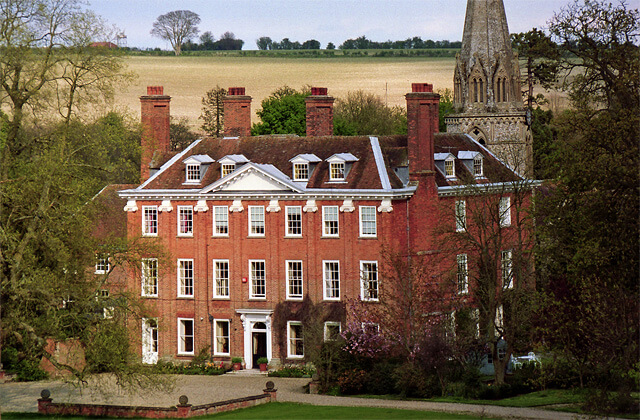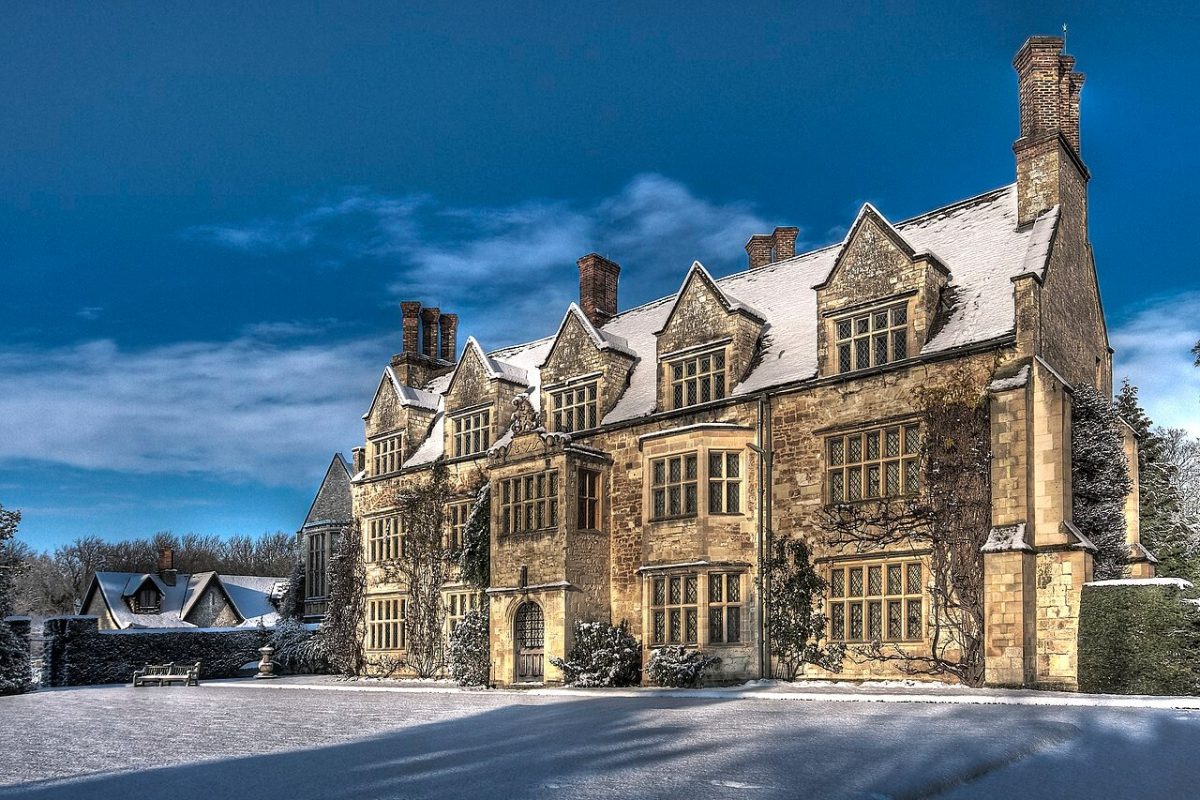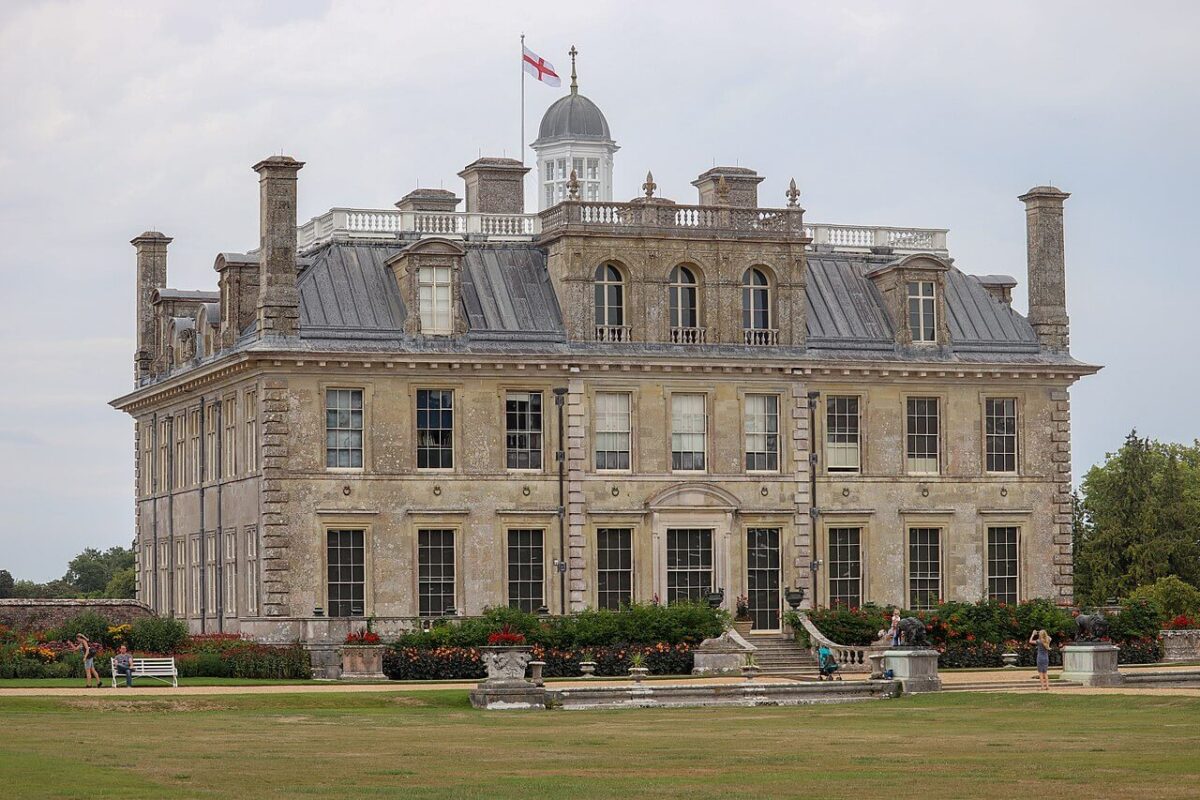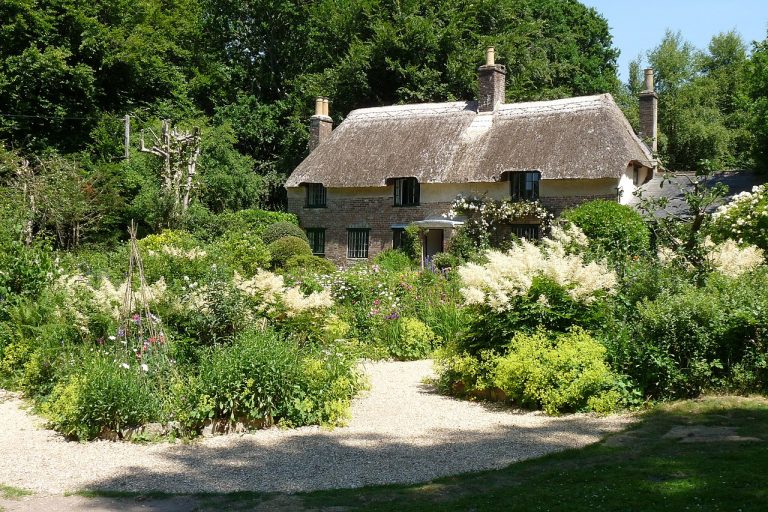20 English Castle Gardens Open for Snowdrop Season in 2026
After the long, dark days of winter, there’s nothing quite like spotting the first snowdrops to lift the spirits. Across England, the grounds of English castles and stately homes open to the public when they come to life, and their gardens burst into bloom with thousands of these delicate white flowers.
It’s the perfect excuse to wrap up warm, pull on your wellies, and enjoy a family stroll through beautiful historic grounds. From winding woodland trails to grand formal gardens, there’s plenty to explore (plus cosy tearooms waiting with hot chocolate and cake at the end of your walk).
Snowdrop season is a gentle reminder that spring is just around the corner, and there’s no better place to enjoy it than at one of England’s magnificent heritage estates. Here is a list of castles, stately homes, and country houses in England open for snowdrop season (in alphabetical order by county).

Moggerhanger Park, Bedfordshire
The woodland trail in the 33 acres of grounds and woodlands at Moggerhanger Park features snowdrops in the winter. The grounds are sculpted by Humphry Repton.
Moggerhanger Park is a late 18th-century country house in Bedfordshire designed by John Soane. The house is one of three houses of John Soane that are still standing. The house and grounds were in a state of disrepair in the late 20th century, but both have been carefully restored and are now open to the public.
When can I see snowdrops at Moggerhanger Park?
Snowdrop season starts late January/early February. The grounds are open daily. Visit the website for more information.

Welford Park, Berkshire
Although Welford Park is a private residence, the grounds, primarily designed by Charles Eyre, have been open to the public for more than 50 years during snowdrop season.
Welford Park is a 17th-century country house and estate in the village of Welford. The house was built around 1652 for Richard Jones, the grandson of Sir Francis Jones, Lord Mayor of London. The house is used as the filming location for the Great British Bake Off.
When can I see snowdrops at Welford Park?
Snowdrop season at Welford Park begins on Wednesday, January 28th, and lasts until Sunday, March 1st. Visit the website for more information.

Anglesey Abbey, Cambridgeshire
The 114 acres of landscaped gardens at Anglesey Abbey are a delight in every season. In the winter months, the gardens are filled with over 500 individual varieties of snowdrops.
Some of these varieties were found at Anglesey Abbey and are therefore named after people and places linked to the estate.
The snowdrops are found along the Winter Walk, the Woodland Path, and Jubilee Avenue.
Anglesey Abbey is a Jacobean country house built on the remains of a priory (hence the name abbey), 5.5 miles from Cambridge. The home features a large collection of art, books, furniture, and objets d’art, curated by Lord Fairhaven, the last private owner who lived here between 1926 and 1966.
When can I see snowdrops at Anglesey Abbey?
The snowdrop season typically lasts from mid-January to late February. Visit the National Trust site for opening times.

Chippenham Park, Cambridgeshire
Thirty-five acres of formal and informal gardens, borders, lakes, woodland walks, and sculptures surround Chippanham Park on the border of Cambridgeshire and Suffolk. The woodland walks are filled with snowdrops in the winter months.
Chippenham Park is a 17th-century family estate built for Admiral Edward Russell, 1st Earl of Orford. The house and the 300 acres of parkland have been lovingly restored and are now available as a wedding venue and hotel.
When can I see snowdrops at Chippenham Park?
The daily snowdrop walks start on Saturday, January 24th, and last until Wednesday, April 1st, 2026. Visit the website for more information.

Rode Hall, Cheshire
The grounds at Rode Hall are one of the few gardens in the North West that open for “Snowdrop Walks.” The park at Rode Hall comprises 10 acres of gardens designed in the late 18th century by Humphry Repton. In the 21st century, an Italian garden was added to the grounds, inspired by the Garden of Ninfa.
Rode Hall is the Georgian country house of the Wilbraham family. The house contains a large collection of paintings, furniture, and porcelain by Chelsea, Bow, and Royal Worcester.
When can I see snowdrops at Rode Hall?
The Snowdrop Walks take place from February 1 to March 1. Visit the website for tickets.

Calke Abbey, Derbyshire
The National Trust manages the landscaped park around Calke Abbey with the intention of nature conservation. It features several gardens and an ancient deep park. The snowdrops are found in the Pleasure Grounds and in the auricula theatre for special displays.
Calke Abbey is an early 18th-century Baroque country house built on the site of an Augustinian Priory. In the 20th century, the house was passed to the National Trust by the Harpur family, and the interiors are deliberately shown in a state of disrepair to illustrate the ‘English country house in decline’.
When can I see snowdrops at Calke Abbey?
Snowdrop season at Calke Abbey is in February. The garden is open daily. Visit the website for more information.
Hopton Hall, Derbyshire
Each spring, the woodlands and gardens at Hopton Hall are filled with thousands of snowdrops, from classic single-petalled flowers to double blooms. With the roots going back to the 18th century, the gardens at Hopton have a story to tell, and the snowdrops are part of that.
Hopton Hall is a 16th-century manor house that was remodeled and extended by Philip Eyre Gell in the 18th century. The estate was home to the Gell family for more than 600 years and hosted many notable figures like Oliver Cromwell, Mary, Queen of Scots, and Queen Caroline.
When can I see snowdrops at Hopton Hall?
The snowdrop walk at Hopton Hall is open every day in February. Visit the website for more information.

Kingston Lacy, Dorset
Kingston Lacy contains acres of parkland and garden surrounding the historic house. In February, the grounds will be covered with six million snowdrops. A signed path will lead you past the beautiful snowdrop display.
Kingston Lacy is a late 17th-century country house that was the family seat of the Bankes family until the 20th century. The home features a beautiful art and furniture collection, curated by avid traveler William John Bankes.
When can I see snowdrops at Kingston Lacy?
Snowdrop season typically begins in late January or early February. Keep an eye on the social media or the website for more information.
Easton Lodge, Essex
The gardens at Easton Lodge in Essex date back to the Tudor times, but the current garden was designed by Harold Peto in 1902. In recent years, the Historic England Grade II Registered gardens have been restored to their former glory by a team of dedicated volunteers and the owners of Warwick House.
Easton Lodge was a Victorian Gothic stately home best known for its society gatherings by the Prince of Wales (the later King Edward VII). It was one of the many country houses destroyed in the 20th century, and today, only part of the west wing remains.
When can I see snowdrops at Easton Lodge?
The gardens will open for snowdrop season on Sunday, February 15, Thursday, February 19, and Sunday, February 22, 2026. Visit the website for more information.

Colesbourne Park and Gardens, Gloucestershire
Colesbourne Gardens features one of the finest and most varied displays of snowdrops in England. The snowdrops, hellebores, cyclamen, and a wide variety of early flowering shrubs can be found in 10 acres of private gardens and woodland walks.
The Colesbourne Park estate houses an elegant Queen Anne home and, later, a grand Victorian mansion. In 1956, botanist and writer Henry Elwes bought the property, demolished the Victorian mansion (with the exception of one room), and built a smaller house.
When can I see snowdrops at Colesbourne Gardens?
The 2026 snowdrop season at Colesbourne Gardens is open to the public every weekend in February (including January 31st and March 1st). Tickets can only be bought online.

Rodmarton Manor, Gloucestershire
Eight acres of Cotswold gardens surround the Arts & Crafts manor house. The garden was designed by Ernest Barnsley as a series of outdoor rooms with a wide selection of planting. In the winter, it is covered with at least 150 different sorts of snowdrops.
Rodmarton Manor is an Arts & Crafts-style manor house commissioned by the Biddulph family in the early 20th century. The residence, along with all its furnishings, adheres to Arts & Crafts principles. Furthermore, it is one of the few remaining houses constructed traditionally, with all components crafted by hand from locally sourced materials.
When can I see snowdrops at Rodmarton Manor?
Snowdrop season is in January/February. Visit the website for current opening times.

Benington Lordship, Hertfordshire
The 7 acres of gardens at Benington Lordship have been carefully planted and updated over the past few years. The snowdrops grow around the moat and castle ruin, and in the early 20th century, a snowdrop walk was planted along the old inner bailey.
Benington Lordship is a grand Georgian house and garden built on the site of a ruined motte-and-bailey castle built in the late 11th or 12th century. Only the foundations of the keep and some earthworks remain of the original Norman castle.

When can I see snowdrops at Benington Lordship?
The gardens at Benington Lordship are open for snowdrop season in 2026 on Saturday and Sunday in February. Visit the website for more information.

Bank Hall, Lincolnshire
The estate of Bank Hall consists of 18 acres of gardens, parkland, and an arboretum. After the garden had been neglected for years, in 2001, the snowdrops were uncovered, and the display is now considered the best snowdrop display in the North of England and one of the finest in the country.
Bank Hall is a Jacobean mansion in Bretherton built in 1608. In the 20th century, the house was in a bad state, but thanks to the Friends of Bank Hall, it is being restored to its former glory.
When can I see snowdrops at Bank Hall?
Snowdrop season 2026 at Bank Hall is on Sundays and Wednesdays in February from 12pm-4pm. Visit the website for more information.

Easton Walled Gardens, Lincolnshire
The 12 acres of gardens were abandoned in the mid-20th century after the historic manor house was pulled down. In 2001, a major renovation project began, by the Cholmeley family (who used to live in the historic home and whose family rebuilt the village in the 19th century).
When can I see snowdrops at Easton Walled Gardens?
The 2026 snowdrop season starts on Wednesday, 11th February, and it is open from Wednesday to Sunday (including Bank Holiday Monday). Visit the website for more information.

Goldsborough Hall, North Yorkshire
The history of the gardens at Golsborough Hall dates back to the 1750s, when Capability Brown-style landscaped gardens were designed. At the beginning of the 20th century, Princess Mary left her mark on the house and gardens following her wedding to Viscount Lascelles.
Gardens with a walled terrace, a beech avenue, and herbaceous borders around Princess Mary’s sundial were created. In 1922, the first tree in the Lime Tree Walk was planted, and the remaining trees were planted by King George V and Queen Mary, among others.
The gardens were severely neglected, but they were replanted in a Gertrude Jekyll-style that suits the style introduced by Princess Mary.
Goldsborough Hall is a Jacobean stately home built for Sir Richard Hutton, a lawyer in London. Currently, the house is a hotel and wedding venue.
When can I see snowdrops at Goldsborough Hall?
The gardens open for snowdrop season throughout February, including two Snowdrop Sundays. Visit the website for more information.

Kiplin Hall, North Yorkshire
The grounds at Kiplin Hall feature formal gardens and parkland, dotted with snowdrops in the winter.
Kiplin Hall is a Jacobean country estate that was originally built as a hunting lodge. Bridget Talbot (the last owner who also invented a waterproof torch for lifebelts, which saved many lives in the Second World War) set up the Kiplin Hall Trust to preserve this unique historic home for future generations.
When can I see snowdrops at Kiplin Hall?
Snowdrop season at Kiplin Hall starts in the first week of February. Visit the website for more information.

Howick Hall Gardens, Northumberland
The gardens at Howick Hall are best known for their spring bulbs and the woodland garden, including a woodland walk through the arboretum. The gardens are mainly the work of the 5th Earl Grey and his wife Mary, who established an informal and natural style of gardening.
Howick Hall has been the ancestral hall of the Earls Grey since the 14th century. The current house was built in the 18th century in a neoclassical style, with interiors that were restored after a fire in 1926.
When can I see snowdrops at Howick Hall Gardens?
The estate opens to visitors at the beginning of February at the start of snowdrop season. Visit the website for more information.

Felley Priory, Nottinghamshire
Although the house dates back to the 12th century, the gardens are a relatively recent addition. It was not until 1890 that the ground was terraced, and since 1976, the current gardens have been developed by Maria Chaworth-Musters.
In the winter, 60 varieties of snowdrops spring up from the ground, including the usual white snowdrops but also rare yellow types.
Felley Priory is a 16th-century manor house that was built on the site of an Augustinian priory. Semicircular columns, believed to be from the priory church, have been reused as gateposts.
When can I see snowdrops at Felley Priory Garden?
The gardens are open to the public from Tuesday to Friday, with the snowdrop season starting around the beginning of February. Visit the website for more information.

East Lambrook Manor, Somerset
The garden at East Lambrook Manor was planted in an informal planting style described as “jungle gardening” by Margery Fish and her husband, Walter Fish, after they bought the house in 1937.
The 2 acres of cottage gardens, surrounding the 15th-century manor house, house the National Collection of Geraniums, as well as a notable collection of snowdrops. Since 1985, the garden has been restored to its original state, as it was left after Margery Fish’s death in 1969.
When can I see snowdrops at East Lambrook Manor?
The 2026 snowdrop season at East Lambrook Manor is in February. Visit the website for more information.

Ickworth Estate, Suffolk
The Ickworth Estate features 1800 acres of parkland and gardens, featuring formal gardens and pleasure grounds. In the springtime, the grounds are adorned with snowdrops, creating a lovely display that hints at the arrival of spring.
Ickworth House is a neoclassical country house in Suffolk. Until the late 20th century, it was the residence of the Marquesses of Bristol, and the National Trust now owns it.
When can I see snowdrops at the Ickworth Estate?
The gardens and house are open year-round. Snowdrop season usually starts in February. Visit the website for more information.





